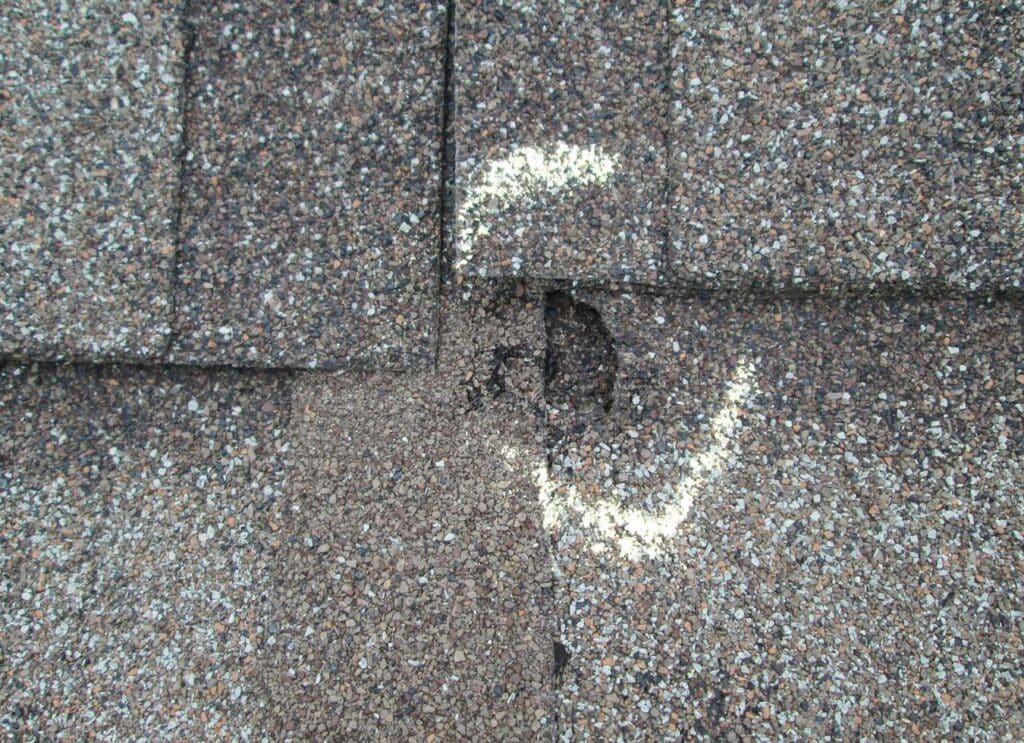Spoiler alert: Yes, it does in MOST cases! 🏠💥 Your homeowner’s insurance typically covers roof damage caused by hail and other extreme weather-related mishaps (we’re talking high winds, fallen tree limbs, the works). But there’s a catch: Insurance companies need clear proof that hail has done its dirty work. This means size matters—precisely, the size and hardness of the hailstone.
If the hailstone is about the size of a marble (1 inch in diameter) or bigger, there’s a good chance your roof has been affected. These larger hailstones can cause visible damage to your shingles and soft metals. However, the ultimate decision on whether your claim is approved depends on what the insurance adjuster finds during their inspection.
If you are reading this blog post and are NOT SURE your roof is covered, PICK UP THE PHONE and CALL your Insurance Agent to check. Some Insurance companies are changing their policies and are “aging out” older roofs for limited or no coverage. You want to ask them if you have an RCV policy (Recoverable Cash Value) that will completely cover the cost of a new roof system. Depreciated coverage can be called ACV or an RSP policy, where they age-out materials as your policy goes on.

How Do You Identify Hail Damage on Your Roof?
So, you know for sure that it’s covered, but how do you figure out if your roof has been damaged after a hailstorm? Don’t worry; we’ve got you.
Before you channel your inner Spider-Man and climb up to the roof (safety first, folks!), look around your yard. That’s right—collateral damage can indicate that your roof might need attention.
Here’s how to check:
On the Roof:
If the hailstones were big enough to mess with your shingles (we’re talking 1” or more), you’ll likely see:
- Dents on asphalt shingles
- Bald spots where granules have been knocked off
- Dinged roof vents, gutters, or flashing (those soft metals are first to go)
Not sure what you’re looking for? We don’t blame you—it’s not like roof damage comes with a giant “X marks the spot.” That’s why having a pro come out to inspect things is always a good idea.
Ground Level:
If you’re not a roof-climbing type (we respect that), walk around your property and look for these signs of collateral damage:
- Dings or holes in your window screens
- Dents in your downspouts, garage door, or painted wood (bonus points if you spot your grill or AC unit getting roughed up)
- Dings on your mailbox, car, or anything metal
Any of these things suggest that the storm also impacted your roof. If you see a few of these signs, it’s time to call your insurance company and start the claims process.

Will Insurance Cover a Full Roof Replacement Due to Hail Damage?
Okay, so now you know your insurance will cover hail damage—awesome! But here’s the burning question: Will your insurance cover a complete roof replacement under your homeowner’s? Well, that depends on your policy.
You might have one of two types of coverage:
Actual Cash Value (ACV) Policy:
This policy pays you the depreciated value of your roof. In simple terms: It won’t cover the full replacement cost. You’ll get a payout based on how much your roof is worth today, which is usually way less than the price of a new one. You’ll likely need to cough up the difference for a complete roof replacement.
(If you’re tempted to go with the lowest bid, remember: cheap materials and shoddy artistry never end well.)
Replacement Cost Value (RCV) Policy:
RCV is the good stuff. This policy should cover the full cost of replacing your roof with a brand-new version. You’ll first get a check for the actual cost value, and once your roof is replaced, you’ll get the rest of the money to cover any depreciation. It’s not always immediate, though—insurance companies like to hold back a little before cutting the final check.
So, while RCV is essential, understanding how your insurance covers hail damage is necessary. Since it is supposed to cover everything, don’t be surprised if it takes patience and persistence to sort it out. Don’t just take the first check and run!

Is Hail Damage to Your Roof an Immediate Concern?
Let’s address the elephant in the room: After a big hailstorm, roofers will knock (some more professionally than others). It’s a classic case of “storm chasers” trying to convince you to get a new roof. Yesterday, we received multiple calls regarding hail damage claims.
But here’s the thing: You don’t have to panic; your home insurance may cover hail damage. You typically have up to a year from the date of the storm to file an insurance claim. Some companies say there’s plenty of time to get a trusted, local roofer (like us at Denny’s Roofing!) to inspect the damage and guide you through the process.
Now, while you don’t need to rush out and sign a contract on the spot, you want to get the ball rolling soon—especially if you suspect severe damage. Your roof needs a timely inspection, but you don’t need to let those fast-talking salespeople push you into making rash decisions.
What’s the Insurance Claim Process Like for a Hail-Damaged Roof?
Alright, your roof’s been hit, your insurance covers it, and you’ve got a handle on whether or not you’re getting a complete roof replacement. Now, let’s talk about the claim process.
First things first: Take a deep breath. The claim process can be long and, let’s face it, a little overwhelming. That’s why we recommend contacting a local, experienced roofing company (hint, hint) that knows the ins and outs of the insurance process, especially when filing a claim for hail damage. We’ve got the experience to help guide you through, step by step.
But before you call your insurer, you’ll want to ask yourself: “Am I comfortable with the process?” If not, don’t stress—we’re here to walk you through it and help you understand every aspect of filing a new hail claim.
Want to know precisely what the claim process looks like? Check out our guide on the insurance process for replacing a storm-damaged roof. We’ll make sure you’re ready for every twist and turn.
Bottom Line: Is Your Roof Ready for the Next Storm?
Hail damage can be a pain, but it doesn’t have to be a headache. Now that you know the ins and outs of insurance coverage, identifying damage, and navigating the claim process, you can take action. Whether you’re dealing with the aftermath of a storm or want to be prepared for the next one, Denny’s Roofing is here to help!
So, next time you see a hailstorm on the horizon, don’t panic. Grab a cup of cocoa, give us a call, and let us help you get that roof back in shape—no matter how big or small the damage.
Need help? Let’s chat! We’re just a phone call away, and we promise we’re way more fun than a storm cloud.

What to Do When Your Roof Damage Insurance Estimate Is Too Low (No, You’re Not Being Price-Gouged!)
Picture this: a storm rolls in, your roof takes a beating, and you’re thinking, “Alright, my trusty homeowner’s insurance will have me covered.” But then, the insurance company sends their estimate… and it’s like they’ve been lowballing the whole thing. You check with your roofing contractor, and their estimate is way higher. Now you’re left scratching your head, wondering if you’re getting played.
First of all, breathe. We get it. It’s frustrating when your insurance estimate falls short of what your roofing contractor says it’ll cost. But hold up—there’s a reason for that, and it’s not because your roofer is trying to pull a fast one.
At Denny’s Roofing, we’ve guided Coloradans through storm-damaged roofs and insurance claims for over 30 years, ensuring that we help our clients maximize their hail damage claims. Let’s explain why this happens, your options, and how to deal with it without losing your cool.
Why Is My Insurance Estimate Lower Than My Roofing Contractor’s?
Okay, here’s the deal: Understanding your insurance premium is crucial before starting any repairs. Insurance companies don’t always have the exact costs in mind as roofing contractors. When you get an estimate from your insurance company, it’s usually based on Xacimate software, which prices things based on industry averages. These numbers might not account for more nuanced details—like local building codes, roofing materials, or even the overhead costs a reputable roofing company needs to stay in business.
On the other hand, roofing contractors factor in more than just the cost of materials and labor. They have overhead, profit margins, and other expenses for keeping the lights on, including your insurance premium. Insurance companies don’t always include those costs in their estimates at first, which means they give you a price that’s often too low to cover the actual cost of the job.
So, while it’s tempting to think the roofer is “up charging,” the reality is that they’re just quoting you what it costs to get your roof fixed properly.
So, What Do You Do If Your Insurance Estimate Isn’t Enough?
Now that you know why the estimates are different, you’re probably wondering—what’s next? If your insurance estimate falls short, here are your three best options:
1. Supplement the Insurance Claim (aka Get Everything Covered)
This one is a bit of a process, but it’s worth it if you want your insurance to cover all the costs. Supplementing means working with your roofing contractor to get the insurance company to approve additional costs left out of their first estimate—things like local code upgrades, disposal fees, labor, and contractor profit.
At Denny’s Roofing, we’re experts at this process. We’ll help you identify any missing line items on the insurance estimate and provide a detailed checklist to send back to your insurance company and get it approved for you so that, most of the time, the only cost to you is your deductible.
Heads-up: Insurance companies can push back on supplements, but you’re paying your premiums for a reason, and they should honor the full policy.
If you find out that you have an ACV or RSP policy, you, the homeowner, could incur additional out-of-pocket costs.
2. Pay Out of Pocket to Make Up the Difference
If you’re not in the mood to wait months for your supplement request to go through, you could always pay out of pocket to cover the difference between the insurance payout and the total cost of your roof replacement.
This option is faster, but it does require you to have some extra cash on hand (or access to credit). If you’re comfortable with the payout and want to get the roof done without the headache of back-and-forth with your insurance company, knowing that you will get it back by the end of the day, this might be your quickest option. Your Project Manager can fully explain it to you.
3. Finance Your Roof Replacement
This one might sound like a new school, but it’s becoming increasingly popular. If insurance doesn’t cover the full cost, you can finance the remainder of your roof replacement—like a car or a new sofa.
This option lets you keep the insurance payout (minus your deductible) and make monthly payments to cover the rest. It’s a pretty straightforward process:
- Get an estimate for your new roof.
- Work with your roofing contractor to arrange financing.
- Depending on your credit, you’ll be approved for a loan, and the payment plan will be determined.
- Once the roof is done, sign off and start making payments.
It’s a win-win: your roofing contractor gets paid what they’re owed, and you don’t have to drain your savings to replace the roof.
Why You Shouldn’t Just Go Price Shopping for Your Roof Replacement
Please search for the cheapest roofer to do the job for whatever your insurance company offers, but they may not help you file a claim effectively. DON’T DO IT.
Here’s why: When you shop for price alone, you create the perfect opportunity for shady roofers to take advantage of your insurance policy. These guys will promise you a bargain, often by cutting corners, using subpar materials, or doing a rush job. Ultimately, you’ll end up paying for it—with your roof’s integrity and possibly your wallet.
We get it. You want to save money, but remember that the cheapest option may not cover hail damage adequately. But you get what you pay for something as important as your roof. That’s why it’s essential to find a local, reputable roofing company that understands how to navigate insurance policies and will work with you to cover your hail damage claim correctly.

Wrapping It Up: What’s the Right Choice for You?
It’s about what works best for you. If you don’t mind waiting and doing some extra paperwork, supplementing your claim could get you the full coverage you deserve. If you need to move quickly or don’t want to deal with the claim process, paying out of pocket or financing might be the way to go.
Whatever route you choose, remember that working with a reputable roofing company can help you file a claim for hail damage. A trusted, experienced roofer (like us at Denny’s Roofing) will make all the difference. We’ll ensure the process goes smoothly and you get the quality roof replacement you need without any stress.
Got questions? Don’t hesitate to reach out! We’re here to help guide you through every step of your roof replacement process—and yes, we’re better than your insurance estimate. 😉

